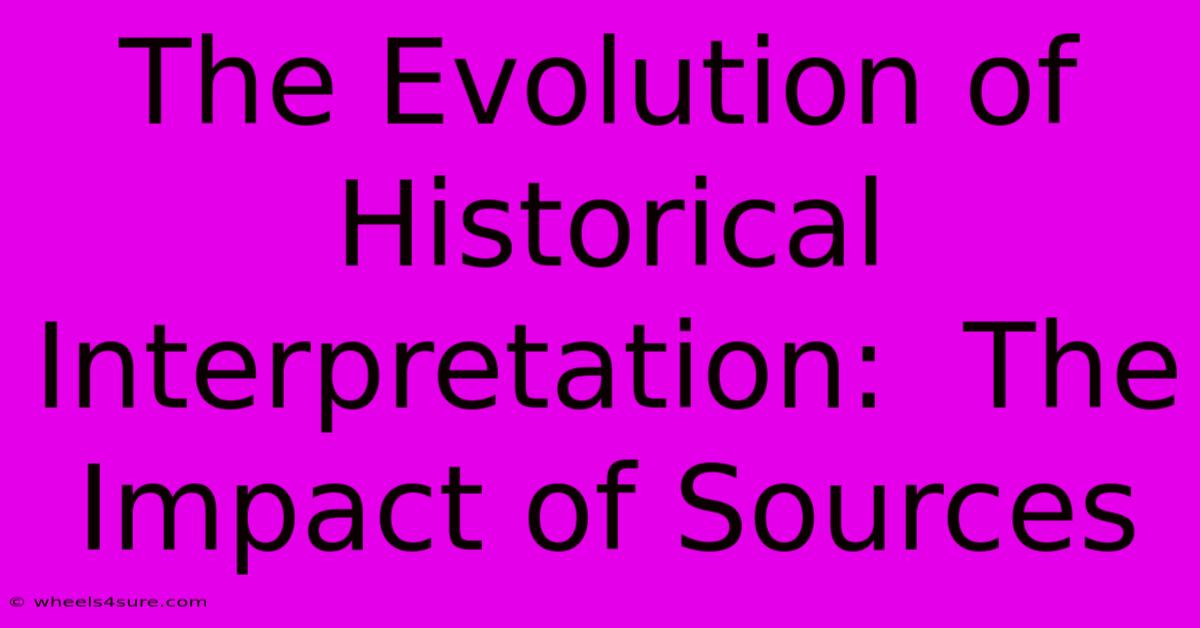The Evolution Of Historical Interpretation: The Impact Of Sources

Table of Contents
The Evolution of Historical Interpretation: The Impact of Sources
History, as we know it, isn't a static entity. It's a constantly evolving narrative, shaped and reshaped by the sources available to historians and the evolving methodologies used to interpret them. The way we understand the past is fundamentally tied to the types of sources we have access to and how we choose to analyze them. This article explores the evolution of historical interpretation, focusing on the crucial role played by the sources themselves.
From Annalistics to Critical Analysis: A Shifting Landscape
Early historical accounts often relied heavily on annalistic approaches. These were essentially chronological lists of events, frequently focusing on rulers and major battles. Think of the ancient chronicles or medieval monastic records. These sources, while providing a basic framework, lacked nuance and often presented a biased perspective, reflecting the values and interests of their creators.
The Rise of Primary Sources
The 19th and 20th centuries saw a significant shift towards a greater emphasis on primary sources. These are materials created during the period being studied – letters, diaries, official documents, artwork, even archaeological artifacts. The focus moved from simply recounting events to analyzing the motivations, beliefs, and experiences of the people who lived through them. This period saw the development of source criticism, a vital skill for historians to evaluate the authenticity, reliability, and potential biases embedded within primary sources.
Identifying Bias: Historians learned to critically examine the context in which sources were produced. Who created the source? What was their purpose? What perspectives might they have excluded? Understanding the limitations and biases inherent in any source is crucial for constructing a balanced and nuanced historical narrative.
The Expanding Source Base: New Perspectives
The 20th and 21st centuries have witnessed an explosion in the types of sources available to historians. The following have significantly impacted our understanding of the past:
Oral Histories: These firsthand accounts, often collected from individuals who experienced particular historical events, provide invaluable insights into lived experiences, especially those of marginalized groups whose voices might have been absent from traditional written sources.
Material Culture: Objects, buildings, clothing, and other artifacts offer tangible connections to the past, allowing historians to reconstruct daily life and social practices in ways that written records alone cannot. Archaeological discoveries, in particular, continue to revolutionize our understanding of pre-literate societies.
Digital Sources: The internet, digital archives, and social media provide vast quantities of new data. Historians can now access digitized primary sources, analyze online communities, and explore digital traces of past events. This presents new opportunities but also new challenges related to authenticity, verification, and the sheer volume of information available.
Interpreting the Past: A Continuous Process
The evolution of historical interpretation isn't a linear progression towards a single "truth." Instead, it's a continuous process of refining our understanding based on new sources, improved methodologies, and evolving perspectives. Different historians, working with the same sources, may reach different conclusions, reflecting the complexities of the past and the subjectivity inherent in historical analysis.
The Importance of Context
The context in which sources are created and interpreted is paramount. Social, political, economic, and cultural factors all influence how we understand the past. For example, the interpretation of a 19th-century political cartoon will differ significantly depending on the historian's understanding of the social and political climate of the time.
Interdisciplinary Approaches
Modern historical research increasingly embraces interdisciplinary approaches. Historians now collaborate with archaeologists, anthropologists, linguists, and other specialists to gain a more comprehensive understanding of the past. This interdisciplinary approach enriches the sources available and expands the range of interpretive possibilities.
Conclusion: The Ongoing Search for Understanding
The evolution of historical interpretation is a testament to the enduring human desire to understand our past. The discovery and analysis of new sources, coupled with the development of sophisticated analytical methods, constantly reshape our understanding of history. The study of history is not about uncovering absolute truths, but rather about engaging in a continuous process of inquiry, interpretation, and re-interpretation, driven by the ever-evolving landscape of available sources. As new sources emerge and methodologies evolve, our understanding of the past will continue to deepen and evolve, offering new insights into the complex tapestry of human experience.

Thank you for visiting our website wich cover about The Evolution Of Historical Interpretation: The Impact Of Sources. We hope the information provided has been useful to you. Feel free to contact us if you have any questions or need further assistance. See you next time and dont miss to bookmark.
Featured Posts
-
Rohit Sharmas Rupees Net Worth Facts And Figures
Apr 12, 2025
-
Brian Littrells Financial Success A Net Worth Story
Apr 12, 2025
-
Rich Dad Poor Dad Pdf Make Money Work For You
Apr 12, 2025
-
You Cant Take My Daughter The Long Term Impact Of Separation
Apr 12, 2025
-
Jk Rowlings Net Worth A Timeline Of Success
Apr 12, 2025
